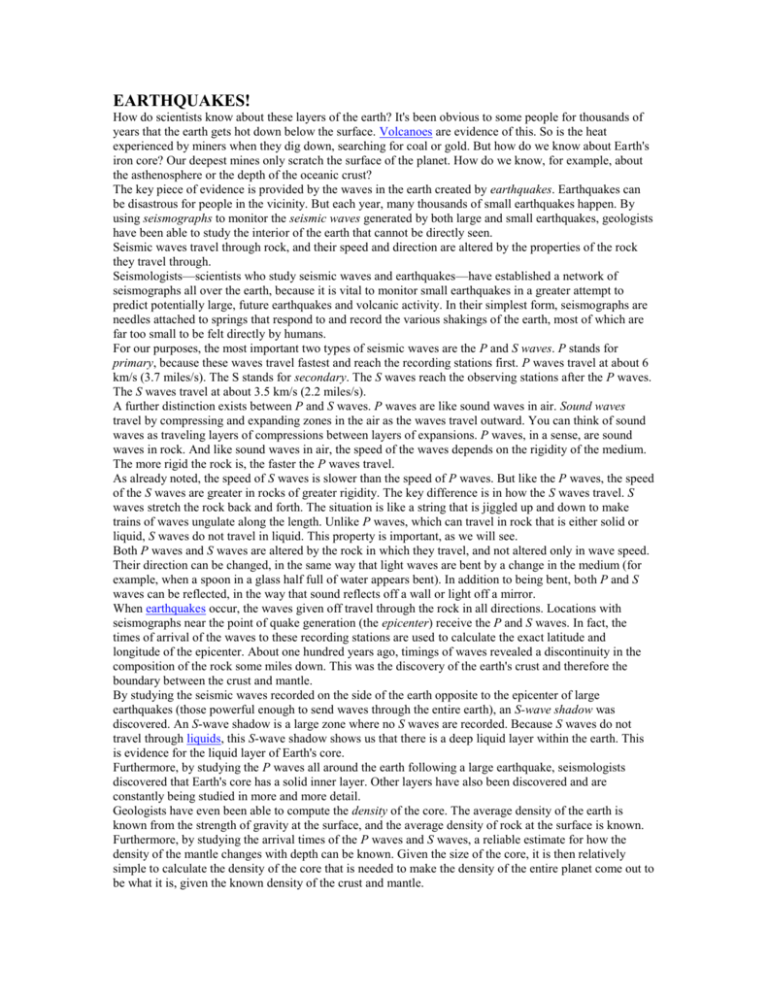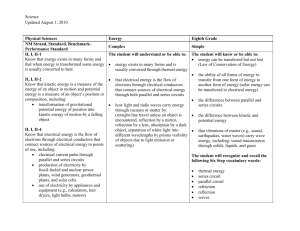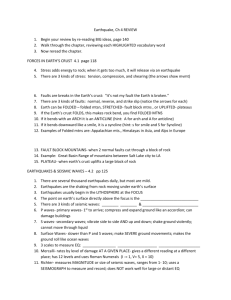Earthquakes! - MsBeckman7thGradeScience
advertisement

EARTHQUAKES! How do scientists know about these layers of the earth? It's been obvious to some people for thousands of years that the earth gets hot down below the surface. Volcanoes are evidence of this. So is the heat experienced by miners when they dig down, searching for coal or gold. But how do we know about Earth's iron core? Our deepest mines only scratch the surface of the planet. How do we know, for example, about the asthenosphere or the depth of the oceanic crust? The key piece of evidence is provided by the waves in the earth created by earthquakes. Earthquakes can be disastrous for people in the vicinity. But each year, many thousands of small earthquakes happen. By using seismographs to monitor the seismic waves generated by both large and small earthquakes, geologists have been able to study the interior of the earth that cannot be directly seen. Seismic waves travel through rock, and their speed and direction are altered by the properties of the rock they travel through. Seismologists—scientists who study seismic waves and earthquakes—have established a network of seismographs all over the earth, because it is vital to monitor small earthquakes in a greater attempt to predict potentially large, future earthquakes and volcanic activity. In their simplest form, seismographs are needles attached to springs that respond to and record the various shakings of the earth, most of which are far too small to be felt directly by humans. For our purposes, the most important two types of seismic waves are the P and S waves. P stands for primary, because these waves travel fastest and reach the recording stations first. P waves travel at about 6 km/s (3.7 miles/s). The S stands for secondary. The S waves reach the observing stations after the P waves. The S waves travel at about 3.5 km/s (2.2 miles/s). A further distinction exists between P and S waves. P waves are like sound waves in air. Sound waves travel by compressing and expanding zones in the air as the waves travel outward. You can think of sound waves as traveling layers of compressions between layers of expansions. P waves, in a sense, are sound waves in rock. And like sound waves in air, the speed of the waves depends on the rigidity of the medium. The more rigid the rock is, the faster the P waves travel. As already noted, the speed of S waves is slower than the speed of P waves. But like the P waves, the speed of the S waves are greater in rocks of greater rigidity. The key difference is in how the S waves travel. S waves stretch the rock back and forth. The situation is like a string that is jiggled up and down to make trains of waves ungulate along the length. Unlike P waves, which can travel in rock that is either solid or liquid, S waves do not travel in liquid. This property is important, as we will see. Both P waves and S waves are altered by the rock in which they travel, and not altered only in wave speed. Their direction can be changed, in the same way that light waves are bent by a change in the medium (for example, when a spoon in a glass half full of water appears bent). In addition to being bent, both P and S waves can be reflected, in the way that sound reflects off a wall or light off a mirror. When earthquakes occur, the waves given off travel through the rock in all directions. Locations with seismographs near the point of quake generation (the epicenter) receive the P and S waves. In fact, the times of arrival of the waves to these recording stations are used to calculate the exact latitude and longitude of the epicenter. About one hundred years ago, timings of waves revealed a discontinuity in the composition of the rock some miles down. This was the discovery of the earth's crust and therefore the boundary between the crust and mantle. By studying the seismic waves recorded on the side of the earth opposite to the epicenter of large earthquakes (those powerful enough to send waves through the entire earth), an S-wave shadow was discovered. An S-wave shadow is a large zone where no S waves are recorded. Because S waves do not travel through liquids, this S-wave shadow shows us that there is a deep liquid layer within the earth. This is evidence for the liquid layer of Earth's core. Furthermore, by studying the P waves all around the earth following a large earthquake, seismologists discovered that Earth's core has a solid inner layer. Other layers have also been discovered and are constantly being studied in more and more detail. Geologists have even been able to compute the density of the core. The average density of the earth is known from the strength of gravity at the surface, and the average density of rock at the surface is known. Furthermore, by studying the arrival times of the P waves and S waves, a reliable estimate for how the density of the mantle changes with depth can be known. Given the size of the core, it is then relatively simple to calculate the density of the core that is needed to make the density of the entire planet come out to be what it is, given the known density of the crust and mantle. The density of the core is nearly four times the density of rock at Earth's surface! The only reasonable substance that we know that would have been around in large enough quantities at the formation of Earth to create a core of that density is iron. This is how we know that the earth has a core that is primarily iron. Finally, the facts that iron has magnetic properties and that the earth has a magnetic field are additional indications that it is indeed iron that forms the bulk of the large spherical core of the earth. Questions: 1. What do seismologists study? _________________________________________________________________________________________ 2. Explain two differences between S and P waves. _________________________________________________________________________________________ _________________________________________________________________________________________ _________________________________________________________________________________________ 3. Which waves do not travel in liquid and why is this important? _________________________________________________________________________________________ _________________________________________________________________________________________ _________________________________________________________________________________________ 4. How did we discover the boundary between crust and mantle? _________________________________________________________________________________________ _________________________________________________________________________________________ 5. What is the evidence that the Earth has a core? _________________________________________________________________________________________ _________________________________________________________________________________________ 6. How do we know that the core is solid and made of Iron? _________________________________________________________________________________________ _________________________________________________________________________________________ _________________________________________________________________________________________ _________________________________________________________________________________________ Analysis: If an earthquake occurred at the dot in the circle below (the circle represents the Earth) what would the wave pattern look like if the Earth’s core was liquid? What does it look like since the core is solid? Liquid Core Normal Earth Core P-Waves








